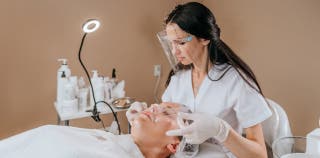What types of business insurance do photographers need?
At a minimum, photographers and videographers should consider getting these 3 types of business insurance:
-
General Liability insurance: Photographer liability insurance protects clients and third parties in case of bodily injury or damage to their property as a result of your business activities.
-
Property insurance: Inland marine insurance and business personal property insurance can protect tools and equipment from loss, damage, and theft either in the field or at your main location of operations.
-
Workers’ Comp insurance: Protects you and your employees if you are injured on the job. Pays for medical bills, lost wages/income, temporary disability, etc.
That said, here’s a broader look at the most common types of business insurance available for photographers and videographers:
What does photographer insurance cover?
What your business insurance will cover depends on the types of policies and coverage you select.
Comprehensive photographer insurance policies should cover the costs of:
- Medical bills for customers and employees
- Repairing and replacing business or customer property
- Paying for lawyers, lawsuits, and settlements
You can customize your photographer insurance to meet your unique business needs. Some of the most important things included in photography insurance include the following.
If you have a photography business with employees, photographer insurance can be an important way to safeguard both the business and its employees. If your policy includes workers’ compensation, it can cover you and your employees if someone gets hurt or sick on the job.
General liability coverage, can protect both your business and its staff against lawsuits and payouts arising from injuries to customers or members of the public and their property due to accidents. It can also protect employees if they accidentally use copyrighted or other protected materials.
Your cameras, equipment, and property
Photographer insurance can also protect your valuable cameras, equipment, and property. It can provide comprehensive coverage for any equipment and other property that is lost or damaged, whether this be through theft, accidental damage, or even vandalism.
In addition to cameras, insurance can cover things like computers and other photo-processing equipment. If a covered event occurs, insurance will not only pay for repairs or replacements, but it may also cover any additional damages resulting from damaged equipment, such as a missed shooting or lost customer photos.
Photographer insurance can protect your business from incidents that could hinder operations. It can include insurance for photography equipment, as well as rented equipment, so you can quickly recover if something is stolen or damaged.
Photographer insurance can also protect against interruptions in your photography business due to natural disasters and other events. It can cover costs such as paying lost revenue if you have to temporarily shut down the business due to an unforeseen event.
How much does photographer liability insurance cost?
Roughly speaking, small photography and videography businesses can pay between $260 and $1,000 per year for photographer liability insurance.
Photographer liability insurance starts as low as $21.25/month*
*Monthly payment calculations (i) do not include initial premium down payment and (ii) may vary by state, insurance provider, and nature of your business.
Averages based on July-September 2023 data of 10% of our total policies sold.
The cost of insurance can be substantially higher if you choose to add other types of coverage, such as commercial property coverage. Coverage can exceed $2,000 annually if you include workers’ comp and protection for expensive commercial property, such as drones.
The cost of photographer insurance can vary greatly depending on several factors, including:
- Type & amount of insurance coverage selected
- Size of your business
- Number of employees
- Operational risks (fieldwork vs studio)
- Your state
Before settling on coverage, take a moment to consider the factors that impact pricing, including the amount and type of insurance that you need to protect your business adequately. We recommend working with an insurance professional to find the right coverage for your business.
(855) 843-2963
Call for a personalized comparison and free quote.
Why do I need photographer insurance?
Professional photographer insurance is essential to protect you, your assets, and your livelihood.
You have likely invested in expensive equipment to carry out your work. This can pose a substantial financial risk if something is damaged or stolen. Additionally, if you routinely interact with the public, you could face significant liability if someone is hurt due to your business operations.
Photographer insurance may include various types of media liability coverage, workers’ compensation, business interruption coverage, and other optional protections. These are all coverages you may need to protect yourself from liabilities arising from client dealings, workplace accidents, and natural disasters that could temporarily halt operations.
How do I buy photography business insurance?
Buying photography business insurance is generally the same as purchasing any other commercial insurance policy.
It first requires assessing your business’s risks and needs, vetting various providers to understand their offerings and potential costs, and binding coverage that fits your budget and risk profile.
Here are the general steps to follow when purchasing photography business insurance:
To find the best insurance for your photography business, you can also speak to an insurance agent who can help you understand your coverage needs.
(855) 843-2963
Call to discuss what type of business insurance is right for you.
Explore related articles by topic
You’ve viewed 3 of 3 articles
LOAD MORE






























